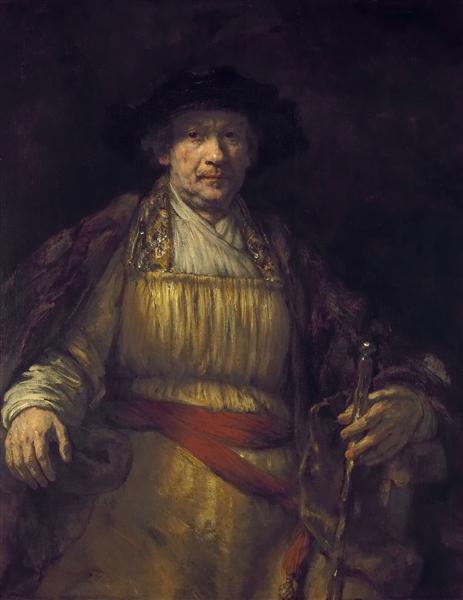Beschreibung
In 1658, Rembrandt van Rijn, one of the greatest masters of Baroque painting, produced a self-portrait that not only captures his physical appearance at a specific moment in his life, but also acts as an emotional mirror, reflecting the nuances of his personality and experience. A masterful example of the use of colour and light, the work reveals Rembrandt’s mastery of chiaroscuro, a technique that allows him to create psychological and physical depth in his portraits.
Looking closely at this painting, we can notice that the self-portrait features Rembrandt in a slight turn to his left, which adds a sense of movement and dynamics to the composition. Although he is the only subject present in the work, the almost intimate approach of this portrait makes it a visual dialogue between the viewer and the artist himself. Shadows fall subtly across his face, revealing a rich, nuanced texture to his skin, while his gaze, both penetrating and reflective, invites the viewer to introspect about his identity and humanity.
The use of colour in this piece is particularly notable. Rembrandt employs a restrained palette that encompasses earthy and golden tones, creating a warm and sophisticated atmosphere. The combination of the brown tones and the golden accents in his clothing contrast effectively with the dark background, making the artist’s face glow. This contrast not only highlights Rembrandt’s facial features, but also emphasises the importance of light in his work; light not only illuminates his figure, but also symbolises truth and revelation in an artistic context.
Throughout his career, Rembrandt produced numerous self-portraits, which serve as a visual record of his personal and professional evolution. By 1658, the artist had already gone through periods of great success, but also of personal and financial difficulties. This self-portrait, in particular, is inscribed at a time of anguish in his life, following the death of his wife, which can be interpreted as a reflection of his psychological state. However, this work transcends the mere representation of suffering, presenting the artist with dignity, seriousness and a contemplative vision that resonates with the universal human experience.
Rembrandt's legacy is unparalleled, and his mastery of portraiture has influenced generations of later artists. This self-portrait from 1658 not only stands as a testament to his technical skills, but also invites the viewer into a deeper connection with the human being behind the work. When contemplating this painting, we are taken on a path of exploration of identity, loneliness, and the complexity of the human soul, characteristics that permeate much of his work. Thus, this self-portrait becomes a work not only of art, but of intrinsic reflection, where each brushstroke tells a story of a man, an artist, and a prodigy who dared to look at his own essence.
KUADROS ©, a famous painting on your wall.
Hand-made oil painting reproductions, with the quality of professional artists and the distinctive seal of KUADROS ©.
Painting reproduction service with satisfaction guarantee. If you are not completely satisfied with the replica of your painting, we will refund 100% of your money.

